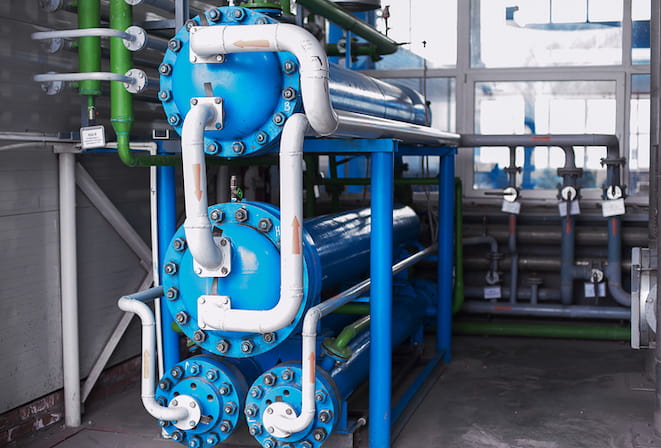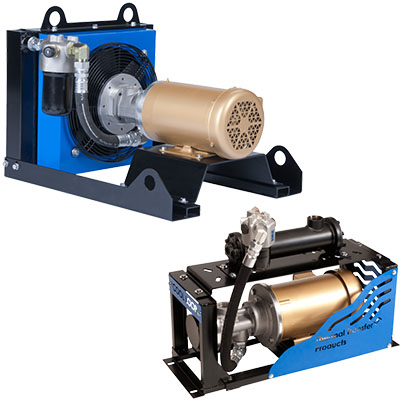Exploring the Conveniences and Applications of Heat Transfer Systems in Modern Industry
Heat transfer systems play a necessary duty in modern sector. They incorporate numerous systems such as radiation, conduction, and convection, each adding to reliable thermal monitoring. Industries like production and aerospace advantage significantly from these systems. As advancements continue, the integration of cutting-edge products and innovations guarantees to boost power performance. This development raises important concerns concerning the future ramifications for sustainability and functional prices throughout several fields. What lies in advance in this continuous transformation?
Understanding Heat Transfer Concepts
Heat transfer concepts are fundamental to the procedure of various industrial systems. These principles include the systems of radiation, transmission, and convection, each playing an essential duty in taking care of thermal energy. Recognizing conduction includes analyzing exactly how Heat relocates with strong products, while convection refer to Heat transfer in fluids, driven by liquid motion. Radiation, unique from the other 2, entails energy transfer via electromagnetic waves. The efficiency of Heat transfer influences system efficiency, power consumption, and total efficiency. Reliable thermal management is essential in processes such as Heat, heating, and cooling recovery. By grasping these principles, markets can maximize their operations, reduce energy expenses, and improve tools longevity, thereby contributing to an extra lasting and efficient industrial landscape.
Secret Kinds Of Heat Transfer Solutions
While numerous sectors use Heat transfer systems for diverse applications, numerous crucial types stand out because of their particular functions and efficiencies. One of the most usual kinds consist of conduction, radiation, and convection systems. Transmission systems transfer Heat through direct contact between products, making them reliable in solid-state applications. Convection systems, on the other hand, make use of liquid activity to transfer Heat, ideal for home heating or cooling liquids and gases. Radiation systems operate without a tool, counting on electro-magnetic waves to transfer Heat, ideal for high-temperature settings. Each kind serves distinctive functions, permitting sectors to tailor their Heat transfer services based upon operational requirements, power performance, and cost-effectiveness. Recognizing these systems is important for optimizing efficiency in various commercial settings.
Industrial Applications of Heat Transfer Technologies
The application of Heat transfer modern technologies in industry plays a necessary duty in boosting power efficiency and enhancing procedures. DVS Heat Transfer Systems. By implementing sophisticated Heat exchange systems, companies can greatly minimize their environmental influence while improving general performance. This integration not just fosters sustainability however also aligns with contemporary regulative and customer needs for greener practices
Energy Performance Improvements
As industries progressively focus on sustainability, power effectiveness enhancements in Heat transfer innovations have actually come to be vital for lowering functional prices and ecological impact. Enhanced Heat exchangers, for circumstances, use advanced products and designs to optimize thermal performance while lessening power intake. Moreover, incorporating variable speed drives in pumping systems enables far better control of fluid flow, causing significant energy cost savings. The implementation of wise sensors and automation gives real-time monitoring, allowing adjustments that optimize energy usage. Furthermore, waste Heat recuperation systems catch excess thermal energy, transforming it into useful power. These advancements not just improve energy efficiency however likewise add to an extra sustainable industrial landscape by reducing greenhouse gas discharges and sustaining conformity with ecological policies.
Refine Optimization Techniques
Process optimization strategies are important in improving the performance and effectiveness of Heat transfer innovations in commercial applications. These methods entail refining procedures to maximize Heat transfer efficiency while decreasing power intake and operational expenses. Approaches such as computational fluid characteristics (CFD) modeling enable engineers to analyze and simulate Heat transfer circumstances, recognizing areas for renovation. In addition, real-time tracking systems can give important information on temperature level gradients and flow rates, enabling changes that enhance performance. In addition, applying innovative control strategies, such as anticipating analytics, can enhance system responsiveness to varying operational needs. By using these optimization methods, sectors can attain better thermal performance, reduced downtime, and boosted item top quality, inevitably causing enhanced competitiveness in the Go Here marketplace.

Ecological Effect Reduction
While industrial Heat transfer innovations are necessary for operational effectiveness, their application additionally provides chances for considerable environmental influence reduction. By boosting energy performance, these systems decrease fuel consumption, causing reduced greenhouse gas discharges. Advanced Heat exchangers can recuperate waste Heat, redirecting it to preheat inbound fluids, therefore minimizing energy requirements. In enhancement, the assimilation of Heat transfer innovations in renewable resource systems, such as solar thermal and geothermal applications, sustains the change to sustainable practices. Industries that use these modern technologies additionally profit from minimized operational prices and boosted regulatory conformity. Generally, the critical execution of Heat transfer systems not just boosts efficiency but also cultivates a more lasting commercial landscape, adding to global ecological objectives.
Benefits of Effective Heat Transfer Equipments
Reliable Heat transfer systems use considerable advantages in modern-day market, mostly via improved power efficiency and price reduction. By optimizing thermal management, these systems lessen energy waste, leading to reduced functional prices (DVS Heat Transfer Systems). Organizations can accomplish greater sustainability and improved success.

Energy Effectiveness Improvements
As industries significantly prioritize sustainability and cost-effectiveness, power effectiveness renovations in Heat transfer systems have emerged as a vital emphasis. Improved efficiency in these systems causes reduced power intake, enabling centers to operate even more sustainably. By enhancing Heat transfer techniques, industries can reduce waste Heat and achieve far better thermal monitoring, greatly lowering their environmental influence. Breakthroughs in innovations such as Heat exchangers and insulation products add to improved performance and reliability. Implementing energy-efficient Heat transfer options not only supports conformity with regulative standards but additionally promotes a society of advancement within companies. Eventually, these improvements are crucial in straightening commercial operations with worldwide energy preservation objectives, leading the way for an extra sustainable future in production and processing fields.
Cost Reduction Opportunities
By optimizing Heat transfer systems, industries can reveal substantial price reduction opportunities that improve their profits. Reliable Heat transfer minimizes power consumption, resulting in reduced energy bills and lessening functional expenditures. Additionally, enhanced system efficiency reduces the need for upkeep and repair services, in addition conserving prices with time. Boosted Heat transfer can additionally expand devices lifespan, permitting business to postpone capital investment on substitutes. Furthermore, waste Heat recuperation systems can transform excess Heat into usable energy, additionally driving down costs. These systems not only enhance procedures but likewise contribute to sustainability initiatives, positioning business positively in a progressively eco-conscious my explanation market. Overall, the financial advantages of efficient Heat transfer systems are vital and significant for competitive benefit.
Technologies in Heat Transfer Solutions
Exactly how can contemporary sector enhance its procedures with cutting-edge Heat transfer options? By embracing innovative products and innovations, sectors can significantly enhance thermal efficiency and efficiency. Technologies such as nanofluids, which boost Heat transfer abilities beyond traditional liquids, and phase change materials that keep and release thermal energy, are obtaining grip. Furthermore, the assimilation of smart sensing units and IoT tools enables real-time tracking and optimization of Heat transfer procedures, minimizing waste and boosting system responsiveness. Additive production methods enable the development of more complicated Heat exchangers that make the most of surface location while lessening product usage. Jointly, these developments drive functional performance and create competitive benefits in different fields, consisting of energy, aerospace, and production.
The Duty of Heat Transfer in Sustainability Initiatives
While the press for sustainability proceeds to reshape sectors, the duty of Heat transfer modern technologies ends up being progressively vital in attaining ecological goals. Effective Heat transfer systems assist in energy efficiency by maximizing thermal management in different procedures, significantly decreasing power usage and greenhouse gas emissions. Progressed Heat exchangers are made use of in industrial applications to recover waste Heat, thus reducing power waste. Furthermore, advancements such as phase adjustment products improve thermal storage, contributing to renewable resource assimilation. Moreover, the adoption of sustainable fluids in Heat transfer systems can lower ecological influence. By focusing on reliable Heat transfer, markets not just improve operational efficiency however likewise line up with worldwide sustainability campaigns, cultivating a cleaner, more lasting future.
Regularly Asked Questions
Exactly How Do Heat Transfer Solutions Influence Power Costs in Manufacturing?
Heat transfer systems markedly affect energy prices in manufacturing by improving effectiveness, decreasing waste, and maximizing thermal management. These improvements bring about lower operational expenses, eventually benefiting general efficiency and success in commercial procedures.
What Upkeep Is Required for Heat Transfer Solutions?
Upkeep for Heat transfer systems consists of regular assessments, cleaning of parts, checking liquid degrees and problems, replacing used components, and guaranteeing appropriate insulation. These activities improve performance, prolong life expectancy, and prevent expensive break downs in operation.
Exist Safety And Security Interest In Heat Transfer Systems?
Safety and security problems with Heat transfer systems consist of potential leaks, pressure accumulation, and thermal threats. Correct layout, regular upkeep, and adherence to safety protocols are vital to minimize these risks and ensure safe operation in industrial settings.
Exactly How Can I Select the Right Heat Transfer System for My Organization?
Choosing the right Heat transfer system involves reviewing factors such as efficiency, application demands, budget restrictions, and safety and security standards. A complete analysis of these Visit This Link components will assist guarantee suitable efficiency and reliability in organization operations.
What Prevail Failings in Heat Transfer Systems and Their Causes?

Recognizing transmission entails evaluating how Heat moves through strong materials, while convection pertains to Heat transfer in liquids, driven by liquid movement. By optimizing Heat transfer techniques, industries can minimize waste Heat and accomplish much better thermal monitoring, significantly decreasing their environmental influence. Waste Heat recovery systems can change excess Heat right into functional energy, additionally driving down expenses. Progressed Heat exchangers are made use of in commercial applications to redeem waste Heat, thereby decreasing power waste. Typical failings in Heat transfer systems include leaks, corrosion, and ineffective Heat exchange.